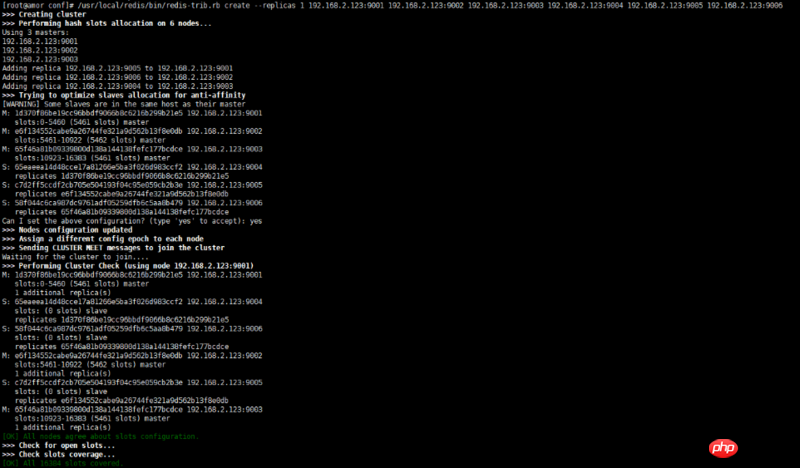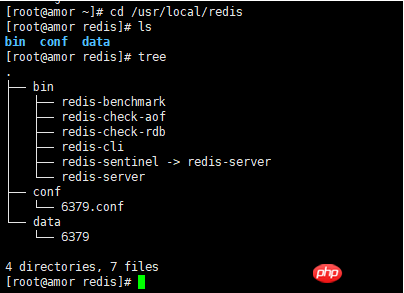Summary of Redis cluster building tutorial
The content of this article is a summary of the Redis cluster building tutorial. The content is very detailed. Friends in need can refer to it. I hope it can help everyone.
Preface
This article collects and organizes web articles, websites, and my own experience in building Redis clusters. The level is limited and only the environment construction is shared. This article is divided into the following parts:
Redis installation
Rvm installation and replacement source
Rvm Ruby installation, use, uninstall
RubyGems upgrade, change source, install redis
Cluster configuration
-
Achievements Test
Please follow the above steps to view this article
Instructions:
For learning purposes only , I do not assume any responsibility if used online.
If you have any questions, please leave a message below.
Some commands in the article do not include sudo because I use root permissions.
Redis installation
Compile and install
wget http://download.redis.io/releases/redis-4.0.10.tar.gz tar xzf redis-4.0.10.tar.gz cd redis-4.0.10 make PREFIX=/usr/local/redis install
Note: If you do not want to use Redis as a service, you have already installed it here
Make Redis a service reference: Redis Quick Start
-
Create a directory where to store your Redis config files and your data: (Youdao Dictionary: Create A directory to store Redis configuration files and data :)

# 这只是一个目录结构,大家不要着急为什么自己没有,往下看,一步一步来 [root@amor ~]# cd /usr/local/redis [root@amor redis]# tree . ├── bin # 编译安装指定目录后自动生成目录及文件 │ ├── redis-benchmark │ ├── redis-check-aof │ ├── redis-check-rdb │ ├── redis-cli │ ├── redis-sentinel -> redis-server │ └── redis-server ├── conf # 自己建立的存储配置文件的目录及自己创建的单个Redis配置文件 │ └── 6379.conf └── data # 自己建立的存储Redis数据的目录及单个Redis服务数据存储目录 └── 6379 4 directories, 7 files
Copy after loginNote:
cp /usr /src/redis-4.0.10/src/redis-trib.rb /usr/local/redis/bin/You will need to use -
Copy later when creating a cluster the init script that you'll find in the Redis distribution under the utils directory into /etc/init.d. We suggest calling it with the name of the port where you are running this instance of Redis. For example: (Youdao Dictionary : Copy the init script found in the Redis distribution under the utils directory into /etc/init.d We recommend calling it with the name of the port on which this Redis instance is running. For example:)
sudo cp utils/redis_init_script /etc/init.d/redis_6379
Copy after login -
Edit the init script.(Youdao Dictionary: Edit the init script.)
#!/bin/sh # chkconfig 2345 90 25 # linux 开机启动设置 2345 运行级别 90 启动优先级(参考 memcached head /etc/rc.d/rc3.d/S90memcached ) 25 关闭优先级 (参考memcached) # Simple Redis init.d script conceived to work on Linux systems # as it does use of the /proc filesystem. ### BEGIN INIT INFO # Provides: redis_6379 # Default-Start: 2 3 4 5 # Default-Stop: 0 1 6 # Short-Description: Redis data structure server # Description: Redis data structure server. See https://redis.io ### END INIT INFO REDISPORT=6379 EXEC=/usr/local/redis/bin/redis-server # 修改为自己的可执行文件所在目录 CLIEXEC=/usr/local/redis/bin/redis-cli # 修改为自己的可执行文件所在目录 PIDFILE=/var/run/redis_${REDISPORT}.pid # 默认就好 CONF="/usr/local/redis/conf/${REDISPORT}.conf" # 修改为自己的配置文件存放目录 ···省略··· esacCopy after loginStart modifying redis.conf
Make sure to modify REDISPORT accordingly to the port you are using. Both the pid file path and the configuration file name depend on the port number. The file names all depend on the port number.)
Set daemonize to yes (by default it is set to no). (Needs to be changed to yes)
Set the pidfile to /var/run/redis_6379.pid (modify the port if needed). (default is sufficient)
Change the port accordingly. In our example it is not needed as the default port is already 6379. (The default is enough, you need to copy the configuration file and reset the port when setting up the cluster)
Set your preferred loglevel. (default is enough)
Set the logfile to / var/log/redis_6379.log (the default seems to be empty and needs to be modified)
Set the dir to /var/redis/6379 (very important step!) (Redis data storage directory, you need to modify the location custom path)
sudo cp redis.conf /usr/local/redis/conf/6379.conf(Modify into a self-defined directory. Refer to the above directory structure redis.conf in the src directory in your redis decompression directory)sudo mkdir /usr/local/redis/data/6379(modify into your own defined directory. Refer to the above directory structure)-
Edit the configuration file, making sure to perform the following changes: (Youdao Dictionary: Edit the configuration file, make sure to perform the following changes: )
注:上面的意思是让你们修改 /usr/local/redis/conf/6379.conf,用vim 打开,搜索上述关键词即可,参考以下设置(如果所有的步骤都是粘贴复制的走下来的,直接修改成下面这样:0.0):
Copy after loginport 6379 daemonize yes pidfile /var/run/redis_6379.pid loglevel notice logfile "/var/log/redis_6379.log" dir /usr/local/redis/data/6379
Copy after login -
Finally add the new Redis init script to all the default runlevels using the following command: (Youdao Dictionary: Finally, use the following command to add the new Redis init script to Added to all default runlevels :)
# ubuntu sudo update-rc.d redis_6379 defaults
Copy after login# centos chkconfig --add redis_6379
Copy after login -
You are done! Now you can try running your instance with:
sudo /etc/init.d/redis_6379 start
Copy after login
test

Redis stop and start
yum installation
/etc/init.d /redis-server stop
/etc/init.d/redis-server start
/etc/init.d/redis-server restart
Three ways to install source code
sudo /etc/init.d/redis_6379 start /usr/local/redis/bin/redis-server redis.conf # 注意此处缺省:配置文件路径 redis-cli -h 127.0.0.1 -p 6379 shutdown
Note: If you just stop local redis, please execute: redis-cli shutdown
Forced termination
kill -9 process numberpkill redis
Rvm 安装 更换源
curl -sSL https://rvm.io/mpapis.asc | gpg2 --import - curl -L get.rvm.io | bash -s stable rvm user gemsets # 建立用户配置目录,更换源的时候需要向 db 文件写入配置信息 echo "ruby_url=https://cache.ruby-china.org/pub/ruby" > ~/.rvm/user/db # 更换源
Rvm Ruby 安装、使用、卸载
rvm list known rvm install 2.6 rvm use 2.6 yum -y remove ruby # 卸载centos yum 安装的 1.8 版本 ruby --version rvm uninstall ruby # 此处带不带版本自己测试
RubyGems 升级、更换源、安装redis
gem install rubygems-update rubygems-update gem sources --add https://gems.ruby-china.com/ --remove https://rubygems.org/ gem sources -l gem install redis
集群配置
注:下面的内容是我自己参考这篇博文加上我熟悉Redis安装后自己的配置过程。大家可以参考NrwLm - Redis 集群搭建详细指南。
开启 Redis cluster
cd /usr/local/redis/conf cp 6379.conf redis.conf.default # 用作集群其他配置文件的蓝本 sudo vim redis.conf.default
修改内容如下
bind 192.168.2.123 # 绑定当前机器 IP cluster-enabled yes # 取消注释,启动集群模式 cluster-config-file nodes-6379.conf # 取消注释,修改为 /usr/local/redis/data/6379/nodes-6379.conf (如果遇到需要重新建立集群,不将此项修改为指定路径而和启动配置文件放在一起,会导致建立集群时,删除重建conf 文件) cluster-node-timeout 15000 # 取消注释 appendonly yes # 将 no 修改为 yes
创建配置文件
cd /usr/local/redis/conf echo 9001.conf 9002.conf 9003.conf 9004.conf 9005.conf 9006.conf | xargs -n 1 cp -v redis.conf.default sed -i 's/6379/9001/g' 9001.conf sed -i 's/6379/9002/g' 9002.conf sed -i 's/6379/9003/g' 9003.conf sed -i 's/6379/9004/g' 9004.conf sed -i 's/6379/9005/g' 9005.conf sed -i 's/6379/9006/g' 9006.conf


创建数据存储文件
cd /usr/local/redis/data mkdir -p 9001 9002 9003 9004 9005 9006 # 后期可能需要删除该文件件下的文件,用于重建集群,所以,删除命令也写一下 rm -rf 900*/*
启动Redis cluster 节点
/usr/local/redis/bin/redis-server /usr/local/redis/conf/9001.conf /usr/local/redis/bin/redis-server /usr/local/redis/conf/9002.conf /usr/local/redis/bin/redis-server /usr/local/redis/conf/9003.conf /usr/local/redis/bin/redis-server /usr/local/redis/conf/9004.conf /usr/local/redis/bin/redis-server /usr/local/redis/conf/9005.conf /usr/local/redis/bin/redis-server /usr/local/redis/conf/9006.conf

创建集群
/usr/local/redis/bin/redis-trib.rb create --replicas 1 192.168.2.123:9001 192.168.2.123:9002 192.168.2.123:9003 192.168.2.123:9004 192.168.2.123:9005 192.168.2.123:9006

测试
执行命令: /usr/local/redis/bin/redis-cli -c -h 192.168.2.123 -p 9001
<img src="/static/imghw/default1.png" data-src="https://img.php.cn//upload/image/755/105/520/1532744572918545.png" class="lazy" title="1532744572918545.png" alt="Summary of Redis cluster building tutorial">
问题汇总
如果遇到timeout 请查看自己的防火墙,安装宝塔的尤其注意,请先去安全里面放行 9001:9006 的端口
redis集群 Waiting for the cluster to join 一直等待,redis集群不仅需要开通redis客户端连接的端口,而且需要开通集群总线端口,集群总线端口为redis客户端连接的端口 + 1000

redis /usr/bin/env: ruby: 没有那个文件或目录执行这个命令
rvm get stable --auto-dotfiles,或者执行nvm list有详细的错误说明(查了资料说,线上不要用rvm安装ruby)-
这是我自己的解决方案
# 把这个添加到 /etc/profile 文件中(放到最后就行) rvm use ruby-2.6.0-preview2
Copy after login

相关推荐:
The above is the detailed content of Summary of Redis cluster building tutorial. For more information, please follow other related articles on the PHP Chinese website!

Hot AI Tools

Undresser.AI Undress
AI-powered app for creating realistic nude photos

AI Clothes Remover
Online AI tool for removing clothes from photos.

Undress AI Tool
Undress images for free

Clothoff.io
AI clothes remover

AI Hentai Generator
Generate AI Hentai for free.

Hot Article

Hot Tools

Notepad++7.3.1
Easy-to-use and free code editor

SublimeText3 Chinese version
Chinese version, very easy to use

Zend Studio 13.0.1
Powerful PHP integrated development environment

Dreamweaver CS6
Visual web development tools

SublimeText3 Mac version
God-level code editing software (SublimeText3)

Hot Topics
 PHP 8.4 Installation and Upgrade guide for Ubuntu and Debian
Dec 24, 2024 pm 04:42 PM
PHP 8.4 Installation and Upgrade guide for Ubuntu and Debian
Dec 24, 2024 pm 04:42 PM
PHP 8.4 brings several new features, security improvements, and performance improvements with healthy amounts of feature deprecations and removals. This guide explains how to install PHP 8.4 or upgrade to PHP 8.4 on Ubuntu, Debian, or their derivati
 How To Set Up Visual Studio Code (VS Code) for PHP Development
Dec 20, 2024 am 11:31 AM
How To Set Up Visual Studio Code (VS Code) for PHP Development
Dec 20, 2024 am 11:31 AM
Visual Studio Code, also known as VS Code, is a free source code editor — or integrated development environment (IDE) — available for all major operating systems. With a large collection of extensions for many programming languages, VS Code can be c
 How do you parse and process HTML/XML in PHP?
Feb 07, 2025 am 11:57 AM
How do you parse and process HTML/XML in PHP?
Feb 07, 2025 am 11:57 AM
This tutorial demonstrates how to efficiently process XML documents using PHP. XML (eXtensible Markup Language) is a versatile text-based markup language designed for both human readability and machine parsing. It's commonly used for data storage an
 PHP Program to Count Vowels in a String
Feb 07, 2025 pm 12:12 PM
PHP Program to Count Vowels in a String
Feb 07, 2025 pm 12:12 PM
A string is a sequence of characters, including letters, numbers, and symbols. This tutorial will learn how to calculate the number of vowels in a given string in PHP using different methods. The vowels in English are a, e, i, o, u, and they can be uppercase or lowercase. What is a vowel? Vowels are alphabetic characters that represent a specific pronunciation. There are five vowels in English, including uppercase and lowercase: a, e, i, o, u Example 1 Input: String = "Tutorialspoint" Output: 6 explain The vowels in the string "Tutorialspoint" are u, o, i, a, o, i. There are 6 yuan in total
 7 PHP Functions I Regret I Didn't Know Before
Nov 13, 2024 am 09:42 AM
7 PHP Functions I Regret I Didn't Know Before
Nov 13, 2024 am 09:42 AM
If you are an experienced PHP developer, you might have the feeling that you’ve been there and done that already.You have developed a significant number of applications, debugged millions of lines of code, and tweaked a bunch of scripts to achieve op
 Why does an error occur when installing an extension using PECL in a Docker environment? How to solve it?
Apr 01, 2025 pm 03:06 PM
Why does an error occur when installing an extension using PECL in a Docker environment? How to solve it?
Apr 01, 2025 pm 03:06 PM
Causes and solutions for errors when using PECL to install extensions in Docker environment When using Docker environment, we often encounter some headaches...
 Top 10 PHP CMS Platforms For Developers in 2024
Dec 05, 2024 am 10:29 AM
Top 10 PHP CMS Platforms For Developers in 2024
Dec 05, 2024 am 10:29 AM
CMS stands for Content Management System. It is a software application or platform that enables users to create, manage, and modify digital content without requiring advanced technical knowledge. CMS allows users to easily create and organize content
 Compilation and installation of Redis on Apple M1 chip Mac failed. How to troubleshoot PHP7.3 compilation errors?
Mar 31, 2025 pm 11:39 PM
Compilation and installation of Redis on Apple M1 chip Mac failed. How to troubleshoot PHP7.3 compilation errors?
Mar 31, 2025 pm 11:39 PM
Problems and solutions encountered when compiling and installing Redis on Apple M1 chip Mac, many users may...








